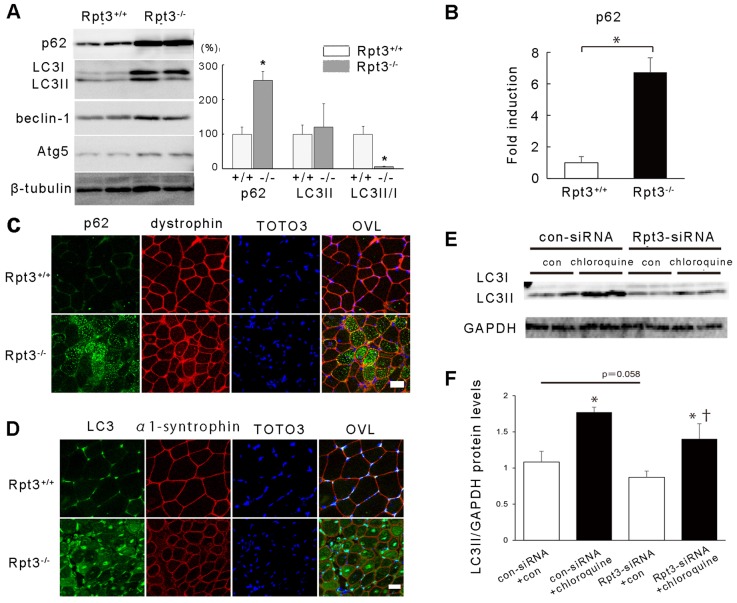Fig. 6.
Autophagy is reduced in the gastrocnemius muscles of Rpt3−/− mice. (A) Immunoblotting revealed increased levels of p62, LC3, beclin-1 and Atg5 proteins in Rpt3−/− mice at the age of 6 weeks. Quantitative data are also presented (n = 3). Note that p62 was increased and the LC3II∶LC3I ratio was decreased in Rpt3−/− mice. (B) Upregulation of p62 mRNA in Rpt3−/− mice at the age of 6 weeks. RNA was extracted from the gastrocnemius muscles, and quantitative PCR analysis was performed in triplicate using specific primers (supplementary material Table S1). Data were normalized to the GAPDH content and expressed as the fold increase over the level of expression in Rpt3+/+ mice (n = 5). (C) Immunohistochemical examination revealed p62-positive myofibers in Rpt3−/− mice at the age of 6 weeks. Scale bar: 50 µm. (D) Immunohistochemical examination revealed LC3-positive myofibers in Rpt3−/− mice at the age of 6 weeks. TOTO3, nuclei; OVL, overlay. Scale bar: 50 µm. (E) Autophagy flux was investigated using C2C12 cells. Representative immunoblotting showing autophagy flux assay with reduced LC3II levels following Rpt3 knockdown under chloroquine inhibition (n = 4/treatment). con, control. (F) The protein level of LC3II was significantly different between vehicle- and chloroquine-treated samples (*P<0.05). The protein level of LC3II was significantly different between samples treated with both Rpt3 siRNA and chloroquine and those treated with control siRNA and chloroquine (†P<0.05). The protein level of LC3II was not significantly different between samples treated with control siRNA without chloroquine those treated with Rpt3 siRNA without chloroquine (P = 0.058). Quantitative data in A,B,F show the mean+s.e.m.; *P<0.05 (Student's t-test).

